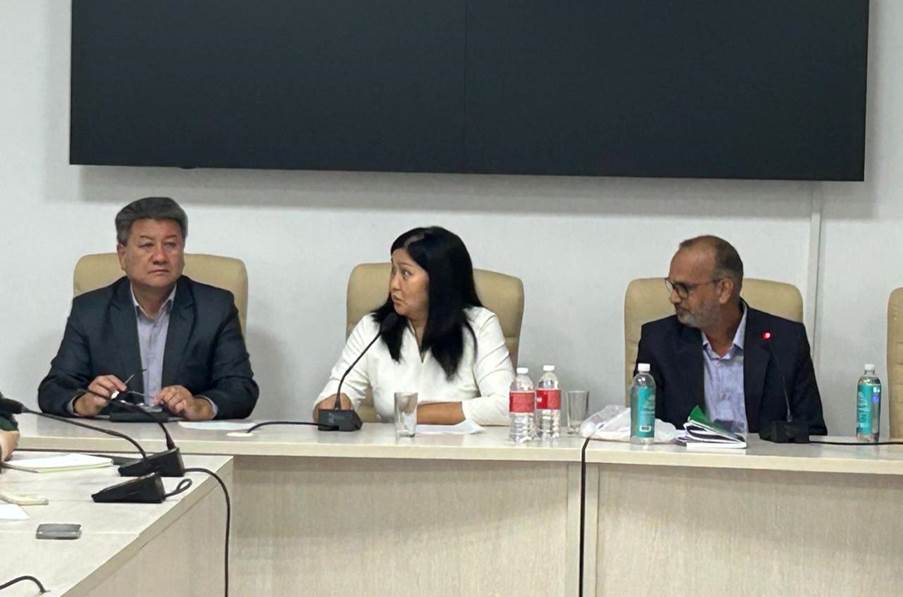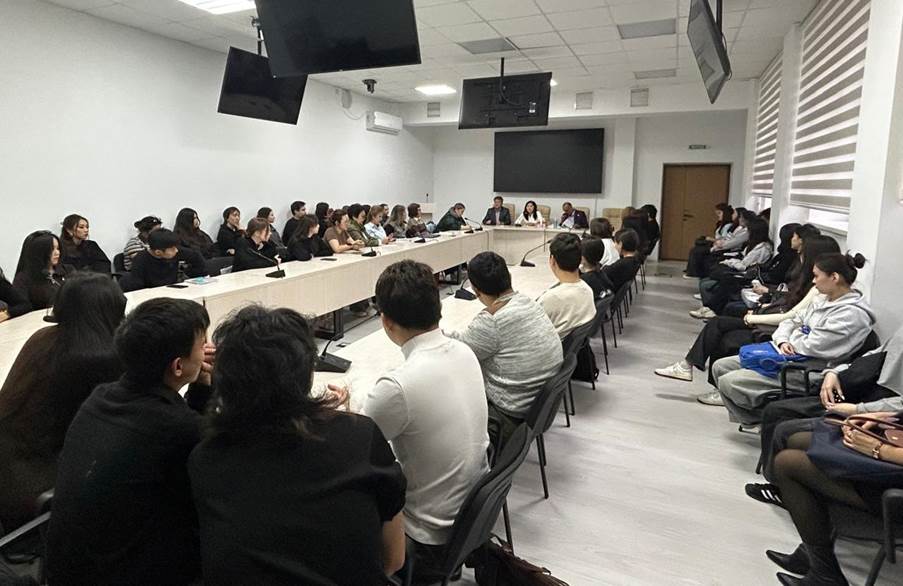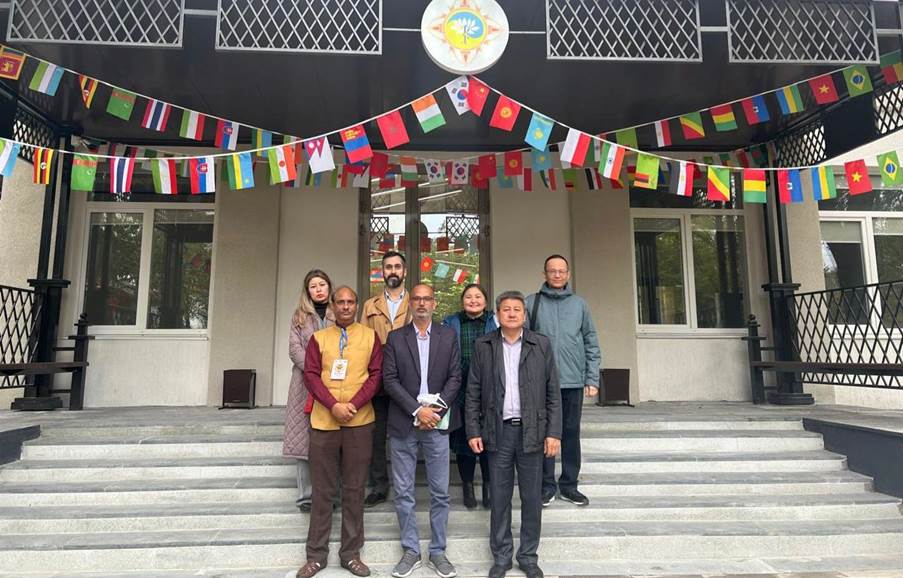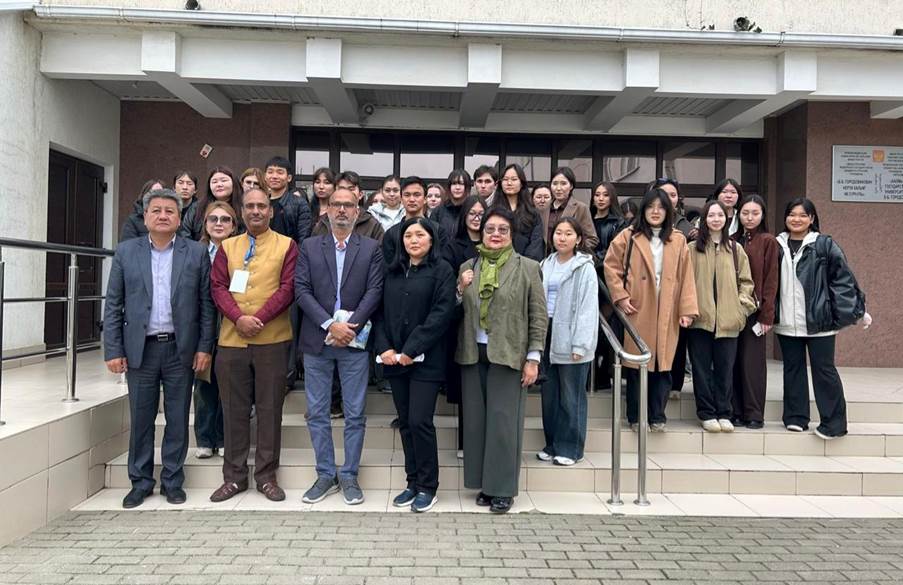Ministry of Culture
Prof. Adarasupally Nataraju delivers special lecture on “Nāgārjuna and Sthiramati on the Nature of Bodhicitta: Some Reflections” during the Exposition of Buddha’s Holy Relics in Kalmykia, Russia
Posted On:
19 OCT 2025 11:00AM by PIB Delhi
As part of the ongoing Exposition of the Sacred Relics of Lord Buddha from India to the Republic of Kalmykia, Russian Federation, a series of academic and cultural programs were organized to promote understanding of Buddhist thought, philosophy, art, and history. Within this framework, Prof. Adarasupally Nataraju, Chairperson, Centre for Philosophy, Jawaharlal Nehru University (JNU), New Delhi, delivered a special lecture on the theme “Nāgārjuna and Sthiramati on the Nature of Bodhicitta: Some Reflections.”

The event was attended by scholars, students, monks, and members of the public interested in Buddhist philosophy and Indian spiritual traditions. The session formed part of a broader set of academic dialogues accompanying the exposition of the Sacred Relics organized by the National Museum, New Delhi, under the aegis of the Ministry of Culture, Government of India, in collaboration with the National Museum of the Kalmyk Republic, Elista.

In his erudite presentation, Prof. Nataraju examined the Buddhist concept of Bodhicitta—the awakened or enlightened consciousness—and explored its intricate philosophical relation to Dharmakāya, the universal principle of purity, compassion, and ultimate reality.

Drawing upon classical Buddhist and Mahāyāna sources, Prof. Nataraju reflected on how Bodhicitta is regarded as a transcendental aspect of consciousness—free from all empirical determinations and beyond the categories of human intellect. Citing the profound insights of Buddhist philosophers Nāgārjuna and Sthiramati, he explained that Bodhicitta is not included in the five skandhas (aggregates), twelve āyatanas (sense bases), or eighteen dhātus (elements), but represents a reflection of the universal consciousness within the human heart.

He observed that Bodhicitta—often described as the “mind of enlightenment”—is the foundation of the Bodhisattva path, combining wisdom (prajñā) and compassion (karuṇā). It is through the realization of Bodhicitta that one moves toward anuttara-samyak-sambodhi, or supreme enlightenment.
Prof. Nataraju emphasized the importance of understanding Pratītya-samutpāda (Dependent Co-arising) and its interrelation with the Second and Third Noble Truths—the origin of suffering and its cessation. He stated that the doctrine of dependent origination reveals that all phenomena arise in mutual dependence, thereby pointing toward the interdependent and dynamic nature of existence.
“Peace, in the Buddhist sense, is not a static condition but a dynamic process arising from the continuous understanding of interconnectedness,” he remarked. “The realization that nothing exists in isolation and that all life is interdependent naturally gives rise to Mahākaruṇā-citta—the compassionate consciousness that forms the ethical foundation of peaceful coexistence.”
Referring to classical and modern interpretations, Prof. Nataraju quoted Theresa Der-Ian Yeh’s summation that “nothing can exist on its own, and everything is dependent on other things… any change in one part of existence influences the whole.” He compared this vision to the metaphor of Indra’s Net from the Avataṃsaka Sūtra, which symbolizes the infinite interrelation of all beings.
In the main part of his lecture, Prof. Nataraju analyzed the interpretations of Nāgārjuna and Sthiramati on the nature of Bodhicitta. Citing Nāgārjuna’s Discourse on the Transcendentality of Bodhicitta, he noted that Bodhicitta is “free from all determinations, uncreated, non-atmanic, and universal.” For Nāgārjuna, understanding Bodhicitta fills the heart with loving kindness, for karuṇā (compassion) is its essence.
He then elaborated on Sthiramati’s view from his Discourse on the Non-Duality of the Mahāyāna Dharmadhātu, where Bodhicitta, Dharmakāya, Tathāgata-garbha, and Bhūtatathatā are understood as expressions of the same ultimate reality. Bodhicitta, he explained, represents the manifestation of Dharmakāya within the human heart—its purification constituting the realization of nirvāṇa.
Quoting D.T. Suzuki’s interpretation in Outlines of Mahāyāna Buddhism (1908), Prof. Nataraju observed that Sthiramati describes Bodhicitta as “the spiritual essence of the Buddhas, the source of all virtues, earthly and transcendental.” Even when momentarily obscured by ignorance or passion, Bodhicitta remains intrinsically pure—its essence indistinguishable from that of the Dharmakāya.
Prof. Nataraju also drew thought-provoking parallels between Buddhist and Vedāntic philosophies, noting similarities in their metaphysical inquiries despite doctrinal differences. He compared the Buddhist notion of Dharmakāya with the Upaniṣadic idea of Ṛta—the cosmic order—whose reflection in human life takes the form of dharma. Similarly, he pointed to the Vedāntic theory of antaḥkaraṇa (internal organ) and its dependence on consciousness for functionality, suggesting that Bodhicitta functions as a reflection of the universal principle of awareness.
He remarked that though Buddhist thinkers often resisted metaphysical speculation, their reflections on Bodhicitta and Dharmakāya inevitably reintroduced transcendental dimensions into Buddhist philosophy. “It is hard to escape metaphysical inquiry,” he noted, “for even silence on the transcendental—as maintained by the Buddha—was a form of profound philosophical communication.”
Prof. Nataraju discussed the ethical and practical implications of cultivating Bodhicitta for individual and collective peace. He outlined ten contemplative steps drawn from Buddhist texts to help realize Bodhicitta in daily life—beginning with reflection on human suffering and culminating in the realization of Bodhicitta as anātman (selfless) and universal.
He emphasized that peace is not merely the absence of violence but a living, dynamic realization of interconnected existence. “The cessation of himsā (violence) comes not from suppression but from the deep understanding of Pratītya-samutpāda, which reveals that our lives are intricately bound together,” he said. “When the human heart is filled with compassion born of understanding, peace naturally follows.”
Prof. Nataraju concluded by observing that the realization of Bodhicitta leads to the dawn of Anuttara-samyak-sambodhicitta—supreme intelligence—that reflects the nature of Dharmakāya. The Buddha’s silence on metaphysical questions, he added, was not a denial of transcendence but an expression of Mahākaruṇā-citta—infinite compassion.
The lecture was one among several academic events organized during the Exposition of Buddha’s Holy Relics in Kalmykia, showcasing India’s profound Buddhist heritage and its enduring influence on global philosophical thought. The program highlighted the shared civilizational ties between India and Russia and the continuing resonance of Buddhist philosophy in fostering intercultural understanding and peace.
***
Sunil Kumar Tiwari
pibculture[at]gmail[dot]com
(Release ID: 2181032)
Visitor Counter : 46